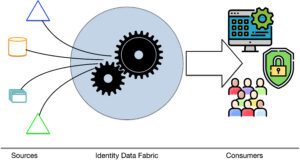The sprawl of information across multiple repositories has complicated managing identity data. The addition of an Identity Data Fabric enables organizations to create a centralized view of identity data for application, security, and user consumption, and it offers a new approach to streamlining and enhancing an organization’s security while simultaneously eliminating complex application integrations.

What is an Identity Data Fabric?
An Identity Data Fabric creates a centralized view of identity data. It allows organizations to manage, govern, and sync data across the infrastructure and secure identity data across all the repositories of available data. An Identity Data Fabric consolidates identity data from various sources, such as directories, applications, and databases. It provides a unified view of this data, allowing organizations to better understand their data across different systems.
An Identity Data Fabric also enables organizations to manage their identity data more effectively and helps ensure that it is accurate, consistent, and secure. An Identity Data Fabric helps organizations improve their security, reduce risk, and comply with regulatory requirements related to identity data.
How Does an Identity Data Fabric Function?
Identity Data Fabric integrates identity data from various sources, including directories, databases, web services, applications, and other sources. It is a centralized Identity Hub for applications, limiting the need for complex integrations. It also ensures that the data collected is normalized to create a unified data repository.
Essential Functions of an Identity Data Fabric:
Centralized Authentication and Authorization: To address an organization’s complex web of identity data, an Identity Data Fabric unifies identities creating a global profile for a user or other object containing identity information. Organizations must update the identity data in near real-time to ensure the security infrastructure can make decisions based on current data instead of periodically refreshed data.
The unified identity profile can be used to identify privacy and compliance concerns. It helps organizations manage identity data quality, providing a framework for compliance applications, limiting the need for the compliance application to build a web of connections to all application repositories to provision identities or perform access audits.
Unified Identity Data without the Need to Statically Represent the Information: Identity Data Fabric allows for creating complex views without complex coding. By extracting the schema of a repository and then building views based on that information, there is no need to develop static repositories of the identity details. This eliminates the need to create new repositories for each application view and enables organizations to extract valuable insights from their identity-related data through UI-driven configuration.
Improved Security: Ensuring that identity data is secure is critical for building an Identity Data Fabric. Unified user profiles can be married with security systems to create robust security measures to protect sensitive information. Since identity is the new security perimeter, having a centralized, up-to-date hub of identity data ensures that risk and other factors can be leveraged to make security decisions.
The Advantages of an Identity Data Fabric
Global User Profile: An Identity Data Fabric allows organizations to build a 360-degree view of identity profiles by aggregating identity attributes from multiple sources. This global profile provides a comprehensive view of identity data, enabling enhanced security and improved views into identity data.
Improved Efficiency: Reducing the time and resources required to access identity data through the global user profile should be important to every organization. Adding an Identity Data Fabric does this, subsequently allowing for faster application development, improved decision making, and an increase in the ability of security systems to make decisions about user access, authorization, risk, and other factors. By improving risk analysis, businesses can reduce MFA fatigue by better determining when to challenge users. Additionally, an Identity Data Fabric provides enhanced availability by leveraging a data cache architecture in case of an identity source outage.
Competitive Advantage: Integrating an Identity Data Fabric allows organizations to gain a competitive edge by providing the opportunity to retire legacy infrastructure and decrease technical debt. Organizations can respond more quickly to identity-related threats, create applications that rely on the global user profile, and improve operations based upon identity-related insights.
Considerations for Implementing an Identity Data Fabric
It is important to consider all the factors when implementing an Identity Data Fabric, including:
- Data disparity across repositories complicates the ability to build a global user profile
- Poor data quality negatively impacts the benefits of an Identity Data Fabric
- How you will handle the security and privacy requirements of the global profile
- Performance and having up-to-date information are necessary for making security decisions
Platforms, like Radiant Logic RadiantOne, provide the functionality to centralize identity information, cache identity data in real-time, and deliver complex logic to unify profiles across repositories. This functionality limits the need for manual or complex data manipulation to build the global user profile.
Conclusion
The ability to manage and leverage identity data is a competitive advantage. Adding an Identity Data Fabric allows organizations to unify identity data, improve security, eliminate complex integrations, support a zero trust strategy, and reduce technical debt. These benefits enable organizations to stay competitive as identity data expands and becomes more complex. Every organization should consider the overabundant benefits an Identity Data Fabric can provide.
Interested in integrating an Identity Data Fabric with AI for user insights? Consider reading, Using an Identity Data Fabric to Extend Artificial Intelligence (AI) to learn how to extend the identity data available to the AI engine to enhance your organization’s ability to gather additional details about the user.


